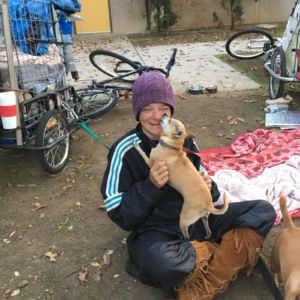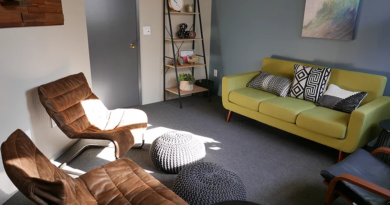The ins and outs of being homeless in Davis

By Claire Bachand,
BlueDevilHUB.com Staff–
The Outs
Trees strung up with lights illuminate downtown Davis’ homey shops and restaurants through a haze as rain patters on the pavement and bars light up. On rainy nights in Davis, some people go to bed hopeful that this will be the last year of California’s drought, while others huddle under awnings and tarps hoping to stay dry.
Sheron is one of these overlooked individuals. As of Nov. 2, she has been homeless for five years, and winter is her least favorite season. It is colder and wetter, and illnesses seem to spread quicker. On rainy days, Sheron shelters where she can.
Some places, such as Community Park and Central Park, close in the evening and if people are found there after closing time, police officers can ask them to leave.
“After you’ve been homeless for a while you get used to it,” Sheron said, explaining that she has been kicked out of Central Park a couple of times.
An employee at City Hall’s Housing Department, Adrienne Heinig emphasizes that these individuals are not being kicked out because they are homeless; they are being kicked out because the park is closed.
“Homeless individuals still have rights to be in public spaces, just like everyone else,” Heinig said.
Still, public places don’t compare to private ones.
“What are you going to do when you don’t have four walls around you to let your emotions out without getting judged? You slug one down to suppress them, but if you slug enough down it doesn’t suppress it anymore,” Sheron’s friend Jessica said.
Bill Pride, Davis Community Meals’ (DCM) Executive Director, estimates that about 80 percent of homeless individuals in Davis suffer from some sort of mental issue or substance abuse problem.
“Being homeless is really hard and gives way to people having substance abuse problems […] and it aggravates mental health issues,” said Eric Elton, Davis’ Interfaith Rotating Winter Shelter’s (IRWS) Board Chair.
“People who are homeless are often jailed for being intoxicated in public […] They are not jailed for being homeless,” Heinig said. According to her, about fifteen homeless people are arrested each quarter.
Other than having to find shelter, homeless people also face the problem of having to find warm clothing.
“You’re constantly having to stay bundled up all the time,” Jessica said.
For the most part, Sheron gets her clothing from thrift stores, but she is always pleased when someone gives her clothing or blankets just out of the blue. Her favorite gift to receive is socks.
DCM, open to the public from eight to 12 every morning, provides the homeless with a variety of services and goods, including showers, toiletries, laundry, counseling, shelter, food and clothing.
Pretty much everything that Davis Community Meals provides is donated.
“Underwear and socks are the big things [in demand],” said Deborah Jory, DCM’s Resource Center Coordinator.
The Ins
While individuals like Sheron wait out the cold and wet nights in the outdoors, other homeless people find shelter at DCM, a church or a transitional housing apartment. These individuals have the luxury of having a bed, from which they can listen to the rain on the roof without feeling it.
Sheron has never stayed at a homeless shelter in Davis, of which there are two, because she has dogs, which aren’t allowed in shelters.
However, Sheron and Jessica have stayed in shelters outside of Davis, where they didn’t always feel safe.
“Nobody knows how to handle behavioral problems,” Jessica said, explaining that this not only leads to safety issues but also results in a bad atmosphere.
“[Volunteers] want to do something good but then become sour because they don’t know how to deal with us,” Jessica said.
Jessica suspects that volunteers expect all homeless people to be the same with the same behavioral problems, but that is not true.
“We are all unique, every one of us,” Jessica said.
“The circumstances which may cause someone to become homeless vary considerably by each individual, and there is not necessarily one type of intervention or service that would impact all types of the population,” Heinig agreed.
Both DCM and the IRWS have trained employees who know how to deal with unexpected behaviors, and have had no conflict worse than arguments and fights at their facilities.
Heinig sees ending homelessness as a team effort.
“Services provided to address the problems faced by individuals and families experiencing homelessness are by their very nature a community-wide effort, with all members of the area, including city and county staff, non-profit service providers, faith-based organizations and community members having a role to play to combat this significant issue,” Heinig said.
According the Heinig, the City of Davis, unlike most cities, dedicates more than $100,000 each year to funding programs aimed at assisting individuals as part of the Yolo County Homeless and Poverty Action Coalition. For example, the City of Davis currently donates to DCM and the IRWS.
In addition, as part of Davis’ affordable housing program, the City currently reserves 29 apartments for individuals hoping to transition out of homelessness and is planning to add 36 more in the near future.
DCM also provides transitional housing for homeless individuals and families. In fact, out of the 16 beds that they provide at their shelter, 14 of of them are reserved for individuals in their program. These individuals have to be sober, capable of living in a community setting and be seeking a way out of homelessness.
Once people get into the program, they can get kicked out for using drugs, violence and theft, amongst other things.
“We’ve had people come in in all sorts of horrific states,” Pride said, going on to explain that when people enter the program with next to nothing and leave it with a place to live or a job, it is incredibly rewarding.
However, this means that Davis Community Meals only provides two beds for individuals seeking shelter from a wet night.
In addition, 12 of the beds are reserved for men and only four of them for women. When the shelter started, this reflected the ratio of women to men living on the street. However, today, this ratio, according to Pride, is closer to three to one.
One side of the well-kept DCM shelter is for men, while the other is for women, making it hard to add more beds for women.
Still, Jory says that she doesn’t have to turn away many women out of lack of room since most women seeking shelter have children.
Although DCM does provide beds, these beds have a greater purpose than getting people out of the cold — they want to get people out of homelessness.
The IRWS, on the other hand, which opens up in late November after Thanksgiving and stays open until mid March, provides beds to anyone looking for one — sober or not.
This shelter moves around from church to church providing beds and food for the homeless, serving up to 40 individuals on any given night.
“You give them these simple things and it really makes their day,” Elton said.
According to Elton, his shelter opens up so late because there is a limited number of sites that they can use as a shelter, and because it is much easier to get volunteers after Thanksgiving when people are in the holiday spirit.
Davis High senior Ben Hoffner-Brodsky has volunteered at the shelter since he was eight.
“I would come in, help serve food and chat with the guests,” Hoffner-Brodsky said. “In activities we designate as ‘volunteering,’ it’s easy to get wrapped-up in doing, working and fixing. The truth is, most guests I talk to are more excited to have a good conversation than to have a hot meal […] I’ve been amazed how easily guests I’ve just met opened up and shared with me a piece of their story,” Hoffner-Brodsky said.
“Almost every night I volunteer I learn just a little bit more and gain a greater appreciation for the complexity beneath every person and just how utterly pointless and inaccurate the assumptions I have about people are,” Hoffner-Brodsky said. “We’re taught to fear people we don’t know, and folks in the homeless community seem even farther away.”
When Hoffner-Brodsky finds himself with an endless list of chores to complete at the shelter, he reminds himself that his hard work will pay off. “I don’t work with the IRWS because it’s rewarding, I do it because it’s right,” Hoffner-Brodsky said.




